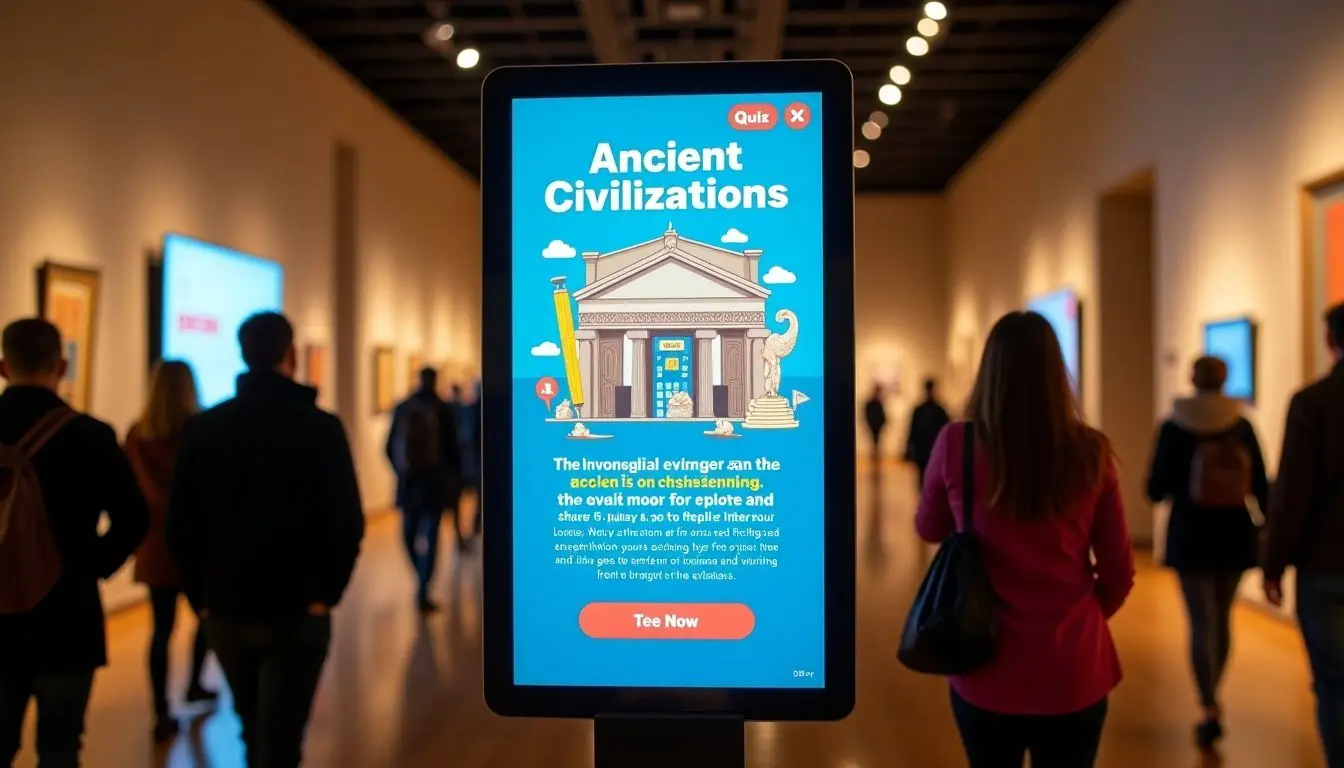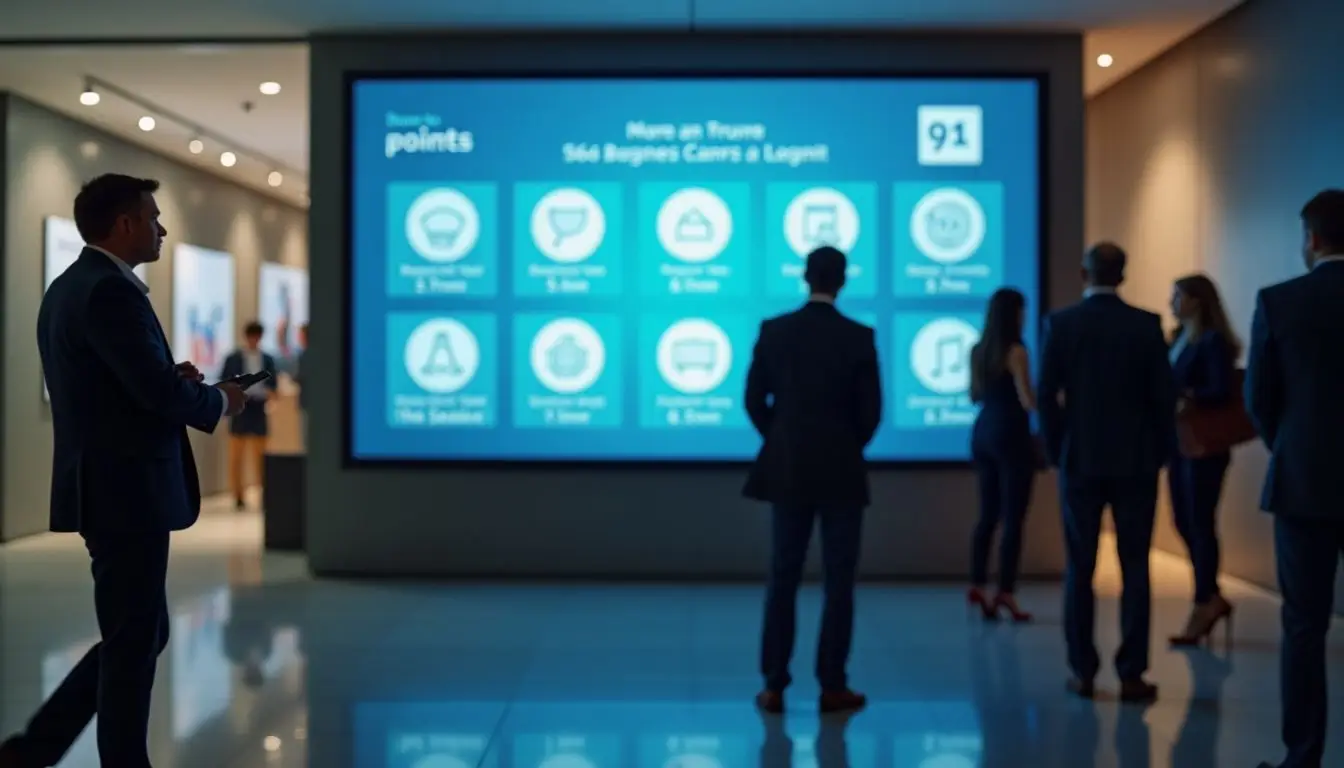Are you trying to make your digital signs more exciting? Many people find that their digital signage fails to grab attention the way they hoped. One key fact is that gamification can really boost engagement and make learning from digital signs fun.
This blog will show you how to use games and interactive technology to catch more eyes. We’ll talk about making your signs not just informative, but also enjoyable. Ready to keep everyone interested?
Key Takeaways
- Gamification uses game features to make learning fun. It helps users learn by doing tasks and earning points, badges, and stats.
- Points show progress, badges reward achievements, and stats track performance. These elements keep users interested in learning or training.
- Using gamification in schools, museums, shops, and for company training can boost engagement. It makes people want to participate more.
- Interactive tech like touchscreens makes digital signs engaging. People enjoy using them because they can interact with the content.
- Games and challenges on digital signs encourage customers to come back. They feel excited to earn rewards while shopping or visiting places.
Understanding Gamification and Interactivity

Gamification and interactivity make learning fun. They use game-like features to engage users in new ways.
Definition and difference between game mechanics and game-based learning
 Game mechanics and game-based learning have different roles. Game mechanics are the rules and elements within a game that make it fun. They include points, badges, levels, and challenges.
Game mechanics and game-based learning have different roles. Game mechanics are the rules and elements within a game that make it fun. They include points, badges, levels, and challenges.
These elements engage users and motivate them to participate. Users can track their progress using these rewards. This type of engagement can lead to better learning outcomes.
On the other hand, game-based learning uses games as the main way to teach something new. It focuses on applying what students learn in a playful context. By mixing storytelling with interactive play, learners connect deeply with content.
The science of gamification shows this method boosts engagement significantly because it involves users actively in their own learning journey.
Benefits of gamification in engagement and learning

Gamification boosts engagement and learning. It uses game elements to make tasks more fun and interesting. Users show increased involvement through interactivity, visual tools, and storytelling.
This mix helps people learn better. Organizations that use gamification see 250% more growth in engagement levels. They also report a 35% decrease in staff turnover and a workforce that is 48% more engaged.
Points are the core of gamification. They mark progress and achievement within any system. Badges can reward users for reaching goals too. These rewards motivate individuals to participate more actively in their learning journey or training sessions.
Interactive features encourage exploration, making experiences richer for users in settings like classrooms or corporate training programs.
Implementing Gamification in Education and Training

Gamification can make learning fun and engaging. It uses points, badges, and stats to motivate students and workers alike.
Three main elements of gamification

Gamification can make learning fun and engaging. It uses game-like elements to motivate users, boost participation, and enhance user experience.
- Points
Points serve as the main currency in gamification. They show progress and achievements. Users earn points through completing tasks or challenges. This system encourages learners to engage more with digital signage content. - Badges
Badges are rewards for reaching specific goals. They symbolize achievement and recognition. Earning badges gives users a sense of accomplishment. This motivates them to keep participating in lessons or training sessions. - Stats
Stats track user performance and progress over time. Users can see how they compare to others or their past performances. This information helps them improve their learning strategies in an interactive environment.
These three elements play a vital role in boosting student engagement through playful learning techniques. Organizations using gamification see up to 250% more growth and a workforce that is 48% more engaged, making it essential for both education and corporate training settings.
Utilizing points, badges, and stats
Points, badges, and stats are key parts of gamification. They motivate users and improve engagement.
- Points: Points serve as the main currency in gamified systems. They show progress and achievement. Users can earn points through interactions or completing tasks. This helps increase user behavior and allows for tracking growth.
- Badges: Badges reward users for specific achievements. They symbolize milestones in a user’s journey. Earning badges boosts motivation and makes users feel recognized. This recognition strengthens learner engagement in educational settings.
- Stats: Stats provide important feedback on user performance. Displaying stats can encourage friendly competition among users. Organizations using these elements see a 250% growth rate and a workforce that is 48% more engaged.
- Tracking Progress: Tracking points over time helps users see their improvement. Users often become more engaged when they notice their progress through gamified experiences.
- Creating Challenges: Points and badges can create fun challenges for users. When users have goals to reach, they tend to interact more with digital signage.
- Celebrating Achievements: Celebrating achievements with badges or special notifications enhances user experience design. This celebration encourages continued interaction.
- Visual Appeal: Using visual elements with points and badges makes engagements more attractive. Bright colors and designs catch attention, making interactive digital signage effective.
- Feedback Loop: A good system uses points and stats to give constant feedback to users. This loop keeps them motivated to return for more interaction.
- Encouraging Participation: Point systems invite customer participation in various activities, from quizzes to surveys in retail environments or museums.
- Building Community: Points earned can also foster community spirit among users, leading to increased customer interaction and loyalty strategies within digital marketing practices.
Incorporating technology for interactivity
Technology plays a key role in boosting interactivity. Touch and gesture technologies make digital signs engaging. Users can interact directly with the display. This interaction creates a fun learning experience.
Gamification strategies enhance user engagement and motivation. For example, users gain points for completing tasks or answering questions correctly. This system leads to higher dopamine levels and helps with knowledge retention in educational settings.
Organizations that use these methods see 250% more growth and 48% more engaged workers. Interactive displays transform how students learn, making lessons memorable and enjoyable.
Real-World Examples of Gamification in Digital Signage

Gamification in digital signage helps engage audiences in fun ways. You can see it in schools, museums, and shops where people earn rewards as they learn or shop.
Enhancing engagement in classrooms and museums
Gamification boosts engagement in classrooms and museums. This method makes learning active and fun. Students connect better through interactive elements, like points and badges. These playful aspects help improve knowledge retention.
Museums use gamification to attract visitors too. They can create experiences that tell stories while guiding guests. People are more likely to engage when they feel part of the action.
Organizations see 250% more growth when using these techniques, leading to a lively atmosphere for all users in educational settings.
Boosting engagement in corporate training
Gamification boosts engagement in corporate training. It adds fun to learning and helps employees stay motivated. Companies using these techniques see 250% more growth. They also experience 35% less turnover.
This means workers feel more connected to their jobs.
Points, badges, and statistics are key tools in this process. These elements show progress and achievements clearly. Interactive features keep employees focused during training sessions.
Using visual elements makes learning enjoyable too. The science of gamification proves that storytelling can capture attention, making training effective and engaging for all users.
Utilizing gamification in retail and data collection
Gamification can boost engagement in retail. It makes shopping fun and interactive. Customers enjoy earning points for purchases. They can also receive badges for completing specific tasks, like trying new products.
This type of rewarding system design keeps customers coming back.
In data collection, gamification turns surveys into games. Visitors answer questions to earn rewards or discounts. This approach increases response rates and gathers more useful information.
Organizations using these strategies see a 250% growth in engagement levels. Gamification not only enhances customer loyalty but also improves the shopping experience overall.
Best Practices for Successful Gamification in Digital Signage

To create effective gamification in digital signage, focus on user-friendly designs that engage customers. This approach can boost loyalty and make interactions more enjoyable. Ready to learn about how to implement these strategies?
Co-designing location-based games
Co-designing location-based games boosts interaction. These games connect users to their surroundings.
- Engage Users with Their Environment
Location-based games use real-world settings. They draw players into a story that fits the place. This makes learning fun and relatable. - Use Points as Progress Markers
Players earn points for tasks completed in different locations. Each point shows their progress. Points create a sense of achievement. - Incorporate Badges for Recognition
Badges reward players for specific challenges or milestones. They serve as visual proof of skills and effort. Badges motivate users to participate more. - Track Stats for Personal Growth
Tracking stats helps players see how they improve over time. This feature shows accomplishments and encourages continued participation. - Blend Storytelling with Visual Elements
A strong story and visuals keep users engaged in the game. Combining these elements supports their learning experience. - Leverage Technology for Interactive Elements
Use smartphones or tablets to deliver interactive content at each location. Technology makes the experience immersive and captivating. - Design Challenges that Fit Locations
Create tasks based on features of each site, like historical facts or unique aspects of a building. This connection enhances user interest. - Promote Teamwork through Group Activities
Adding team challenges fosters collaboration among players, helping them work together towards common goals while learning key concepts. - Focus on Learning Outcomes
Games should have clear educational goals tied to local experiences or facts about subjects like history or science, ensuring knowledge retention is boosted through gamification strategies. - Collect Data to Improve Engagement Strategies
Gather feedback from participants after gameplay sessions to enhance future experiences and adjust strategies, ultimately driving better audience engagement over time.
Gaining insights from co-designing location-based games encourages a more active role in learning while enhancing motivation overall.
Using gamification to enhance customer loyalty
Gamification can boost customer loyalty in many ways. It adds fun and excitement to the shopping experience. By using points, badges, and stats, customers feel rewarded for their actions.
This makes them more likely to return.
Organizations that use gamification see great results. They enjoy 250% more growth and a workforce that is 48% more engaged. Loyal customers stay longer and spend more money. Gamification creates exciting experiences for users.
Engaging games encourage visitors to come back again and again.
Developing a comprehensive engagement framework
Creating a complete engagement framework is essential for success. This framework should focus on interactivity and gamification in digital signs. Points are key; they show progress and achievement.
Badges can motivate users by giving them recognition for reaching goals. Stats help users track their success.
Organizations that use gamification techniques see major benefits. They experience 250% more growth and 35% less turnover. Employees become 48% more engaged when playful elements are included in training or learning environments.
Effective designs involve user feedback to ensure that the experiences match their interests and needs, enhancing overall interactive engagement.
Integrating game design theory and behavior analysis
Game design theory and behavior analysis work well together. They help create engaging experiences in digital signs. Gamification improves user engagement by adding fun elements to learning.
Points, badges, and stats motivate users to learn more effectively.
Using these theories can increase growth for organizations. Studies show that companies using gamification grow 250% more than others. Less turnover happens too, with a drop of 35%.
Employees become 48% more engaged when they enjoy their tasks at work or school. Engaging students and employees leads to better retention of knowledge and improved motivation overall.
Conclusion

Gamification and interactivity boost engagement in digital signs. They make learning fun and memorable. Using elements like points, badges, and stats encourages users to participate actively.
These tools are easy to incorporate into schools and businesses alike. Think about how you can use these strategies today. Engaging students or employees leads to better results for everyone involved.
Start creating a more interactive experience that truly connects with your audience!
FAQs
1. What does “Mastering the Art of Engagement: Interactivity and Gamification in Digital Signs” mean?
It refers to the process of creating engaging, interactive digital signs using gamification. This involves using game elements to motivate user experiences and boost engagement.
2. How can businesses benefit from interactivity and gamification in digital signs?
Businesses can use these methods to create motivating user experiences that engage customers more deeply. It’s a trend that’s transforming how businesses interact with their audiences.
3. Can I apply a learning framework for mastering interactivity and gamification in digital signs?
Yes, a well-designed learning framework can guide you through the process of incorporating interactivity and gamification into your digital signage strategy effectively.
4. Are there any trends related to interactivity and gamification in business marketing?
Indeed, implementing interactivity and gamification strategies is becoming one of the key business trends for enhancing customer engagement through effective signage.





